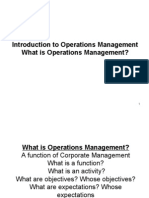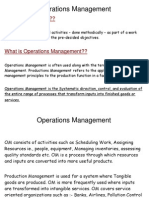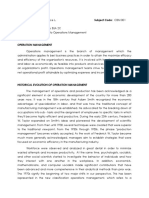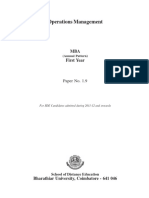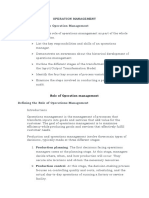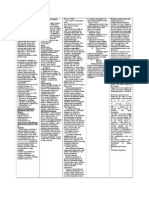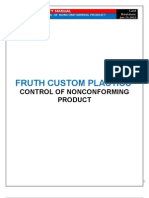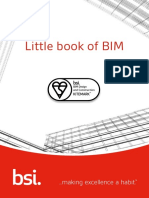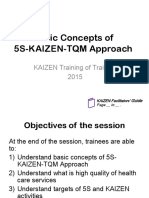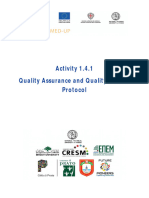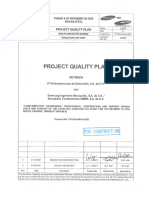Operations Analytics/
Service Management in Key
LECTURE 37-38
Introduction to
Operations Management
�Operations Management
Operations management is a crucial aspect of organizational functioning, overseeing the
production of goods and services. Its primary goal is to ensure efficiency, effectiveness, and
competitiveness in delivering products or services to customers.
Consider companies such as McDonald's. Its success hinges on efficient operations – from taking
orders to delivering your favorite meal quickly. How does the role of operations management
manifest in your McDonald's experience?
Role and Importance of Operations Management
Now, let’s understand the role of operations management.
§ Efficiency: Operations management optimizes processes to minimize waste, reduce costs, and
enhance productivity. This leads to better resource utilization and cost-effectiveness.
• Quality Control: Operations managers ensure that products or services meet or exceed the
required standards. This is vital for maintaining customer satisfaction and reputation.
• Customer Satisfaction: Timely delivery, quality products, and reliable services increase
customer satisfaction. Operations management plays a pivotal role in meeting customer
expectations.
• Supply Chain Management: Operations management oversees the entire supply chain, from
raw material procurement to product delivery. Effective supply chain management ensures a
steady flow of resources and finished products.
§ Innovation: Operations managers often seek ways to improve processes and introduce
innovations. This could involve adopting new technologies, streamlining workflows, or
implementing best practices.
For example, Tata Motors
§ Role: Tata Motors, a leading automotive manufacturer, relies on
operations management to ensure efficient production, high-
quality vehicles, and timely delivery.
§ Importance: Operations management contributes to Tata Motors'
reputation for manufacturing reliable and quality automobiles.
Key Functions and Activities
Now, let's zoom into the key functions and activities in operations management. Whether managing
inventory, ensuring quality control, or optimizing processes, these gears keep the business engine
running smoothly.
1. Product and Service Design: Design products or services that meet customer needs and
can be produced efficiently.
2
�2. Capacity Planning: Determining the capacity needed to meet demand while considering
efficiency and cost.
3. Process Design and Management: Designing and managing the processes of producing goods
or delivering services.
4. Quality Management: Implementing systems to maintain and improve the quality of products or
services.
5. Inventory Management: Managing the levels of raw materials, work-in-progress, and finished
goods to optimize costs and meet demand.
6. Supply Chain Management: Coordinating the entire supply chain, including suppliers,
manufacturers, distributors, and retailers.
7. Logistics Management: Ensuring the efficient movement of goods from production to
distribution to the end customer.
8. Scheduling: Creating production schedules to meet demand while maximizing efficiency.
For example, Hindustan Unilever Limited (HUL)
§ Product and Service Design: HUL continually designs and
introduces new products that cater to diverse consumer needs.
§ Quality Management: HUL emphasizes quality control in
producing its consumer goods, including soaps, detergents,
and personal care products.
Exploring the Historical Evolution
Operations management has a rich history that evolved alongside industrialization.
Consider Henry Ford's assembly line – a revolutionary concept in its time. How did this historical shift
in production methods influence operations management?
1. Craft Production: Early stages involved individual craftsmen producing goods manually.
2. Industrial Revolution: Mass production and assembly lines were introduced, increasing
efficiency but often sacrificing customization.
3. Scientific Management: Frederick Taylor's principles focused on optimizing individual tasks for
efficiency.
4. Quality Management: Post World War II, a focus on quality emerged, led by figures such as W.
Edwards Deming and Joseph Juran.
5. Lean Manufacturing: From Toyota's production system, lean principles aimed at minimizing
waste and maximizing efficiency.
3
�For example, Tata Steel
§ Craft Production: Tata Steel has its roots in traditional
metalworking, representing the early craft production phase.
§ Industrial Revolution: Over time, Tata Steel embraced
technological advancements and adopted more efficient
production methods.
Operations Management Strategies
Finally, let's explore the strategies.
Companies employ various approaches to optimize operations.
6. Cost Leadership: Focus on minimizing costs to offer products or services at a lower price than
competitors, often achieved through economies of scale and efficient operations.
7. Differentiation: Emphasizes unique features, innovation, or superior quality to distinguish
products or services in the market.
8. Agility: Prioritizes flexibility and responsiveness to adapt quickly to changing market conditions
or customer demands.
9. Quality Focus: Concentrates on delivering high-quality products or services to build a strong
reputation and customer loyalty.
10. Global Operations: Expanding operations globally to access new markets, resources, or cost
advantages.
11. Sustainability: Integrating environmentally sustainable practices into operations to meet
growing demand for socially responsible business practices.
For example, Maruti Suzuki India Limited
§ Cost Leadership: Maruti Suzuki has achieved cost leadership in
the Indian automotive market by optimizing production processes
and achieving economies of scale.
§ Agility: The company adapts to changing consumer preferences by
introducing new models quickly and efficiently.
References:
§ Hayes, A. (2024, February 23). Operations Management: Understanding and using it. Investopedia.
https://www.investopedia.com/terms/o/operations-management.asp




